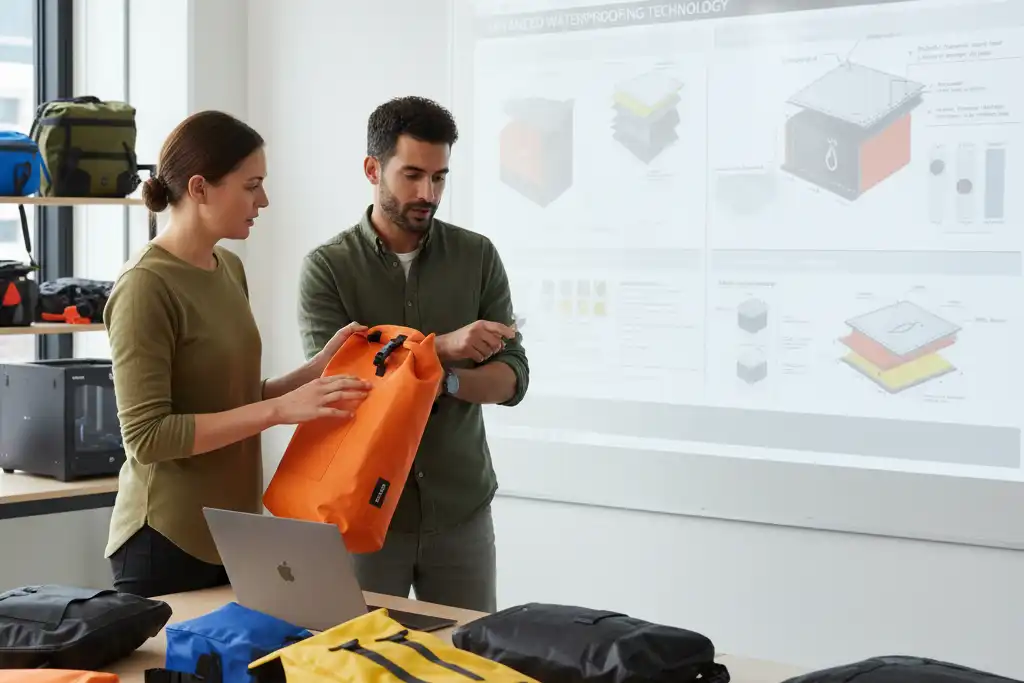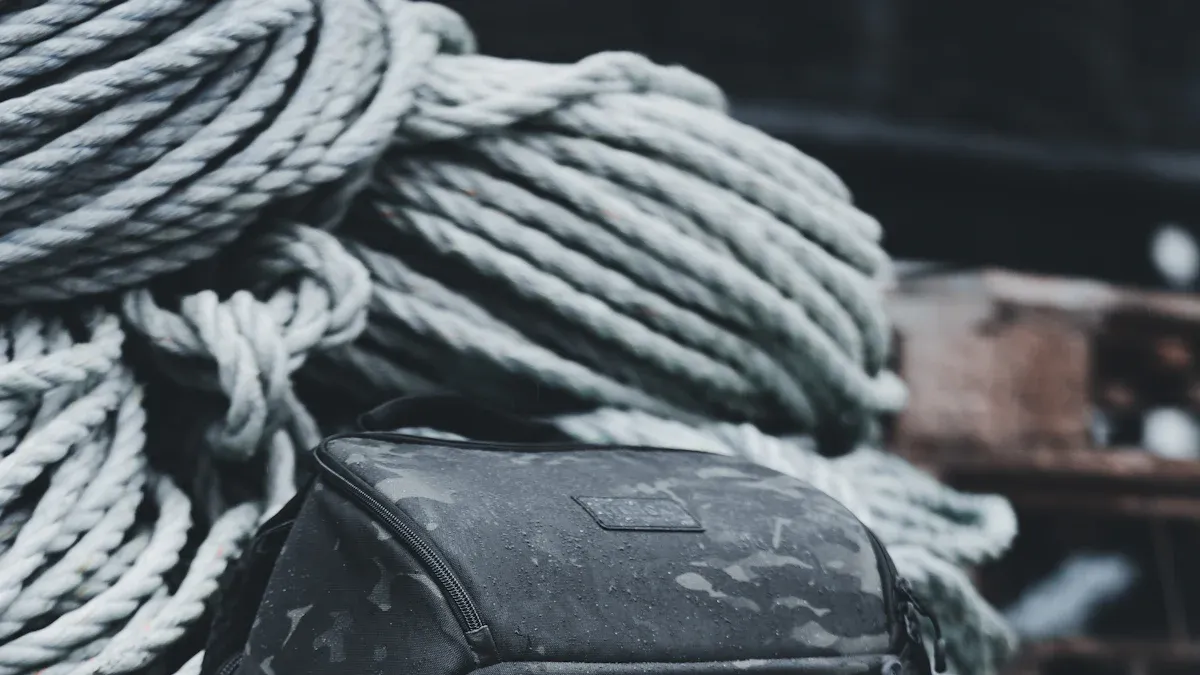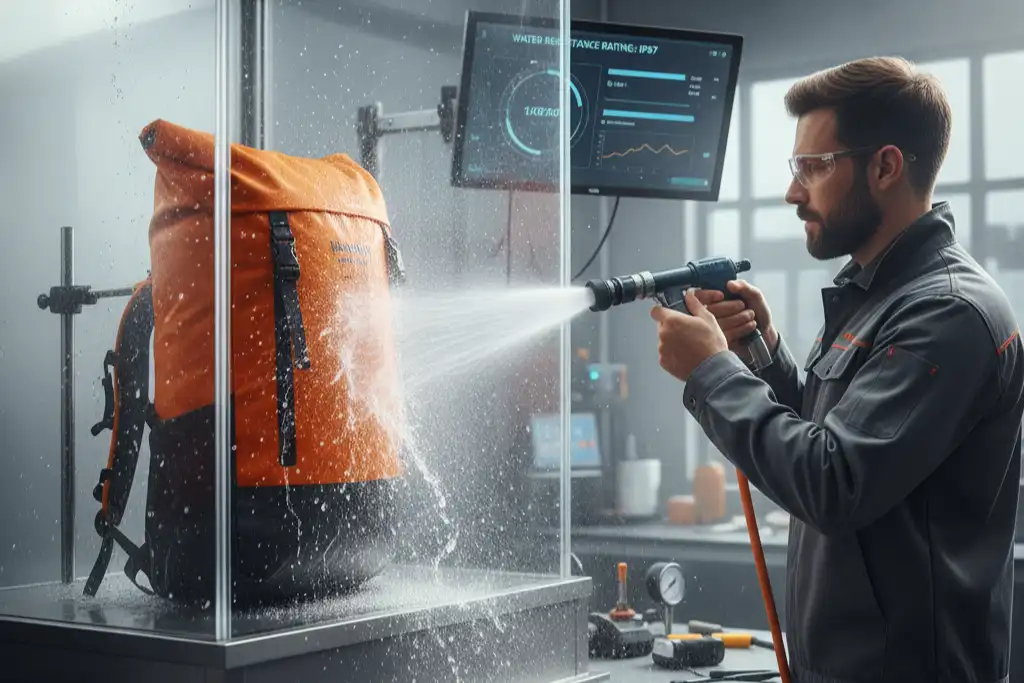The Evolution of Waterproof Backpack Technology

Imagine you are hiking and it starts to rain hard. You know your stuff will stay dry. This is because Waterproof Backpack Technology has changed a lot over time. Big changes happened with Gore-Tex and LONGHIKER’s first waterproof bags. Now, there are even more cool changes:
- Nanotechnology fabrics make backpacks last longer and protect your things.
- Smart features like GPS tracking and solar charging help you on trips.
- Eco-friendly designs show you care about nature.
Key Takeaways
- Waterproof backpacks have changed a lot over time. They use strong materials like Gore-Tex and eco-friendly fabrics. These keep your things dry and help the planet.
- Smart features like GPS tracking and solar charging make backpacks more useful. These features help people who love adventure.
- Backpacks with welded seams and strong zippers work better. They keep water out and last longer. Your gear stays safe in any weather.
- Eco-friendly materials, like recycled polyester and biodegradable fabrics, help the Earth. They lower pollution and waste. You can help the planet while having fun outside.
- More people want waterproof backpacks now. New designs and technology help people who care about the planet and love gadgets.
Origins of Waterproof Backpacks
Early Waterproof Materials
Waterproof backpacks are not a new thing. People tried to keep their stuff dry a long time ago. Early humans used things they found around them. Look at this table to see what they used:
| Material | Description | Effectiveness |
|---|---|---|
| Animal and Plant Fats | People put fish oil and whale blubber on cloth. | Good for simple waterproofing. |
| Wax | Cloth soaked in hot wax was used in Europe. | Helped keep tents and clothes dry. |
Long ago, there was no fancy gear. People used easy tricks to stay dry. Waxed canvas and oilcloth were popular with explorers and sailors. These kept water out but felt heavy and stiff. LONGHIKER made the first outdoor waterproof bag. Now, you could carry your things in a bag that stopped rain and mud.
Historical Methods and Limitations
Did those old ways work well? They helped, but had problems:
- Bags did not last long.
- You had to add more wax or oil often.
- Bags worked differently when the weather changed.
Think about hiking with a heavy, sticky bag. You would want something better. That is why Waterproof Backpack Technology kept getting better. People wanted bags that were light, strong, and easy to use. The change from animal fats to new materials shows how much things have improved.
Material Breakthroughs

Gore-Tex and PVC Innovations
Have you ever wondered how backpacks keep your things dry? This happened because of new materials. Gore-Tex changed everything when it was invented. The fabric has many tiny holes. Water cannot get in, but sweat and heat can leave. So, you stay dry inside and outside. This helps if you are hiking in rain or running to school.
PVC is another important material. It is very strong and keeps water out. Early waterproof backpacks used a lot of PVC. It worked well to block water. But PVC does not let air move through. If you pack lunch or gym clothes, they might feel damp inside.
Here is a table that shows how these materials compare:
| Material | Key Features | Impact on Performance Metrics |
|---|---|---|
| GORE-TEX (ePTFE) | Billions of microscopic pores, waterproof yet breathable | Prevents water from getting in, lets sweat out, keeps you comfortable |
| GORE-TEX (ePE) | Thinner, lighter, quieter, no PFAS | Still waterproof and breathable, better for the environment |
| PVC | Super durable, waterproof, less breathable | Great at blocking water, but can trap moisture inside |
Gore-Tex became popular with people who love the outdoors. It made Waterproof Backpack Technology smarter and more comfy.
Nylon, Silnylon, and Polyester Advances
Now, let’s talk about nylon, silnylon, and polyester. These materials made backpacks lighter and stronger. If you like hiking or biking, you want a bag that does not rip.
- Nylon is very strong. It does not tear or scratch easily.
- Polyester is good for daily use. It is not as strong as nylon, but it works for school.
- Silnylon is nylon with a silicone coat. This makes it even more waterproof and lighter.
Studies show how strong these materials are:
- A 1000D nylon backpack can hold up to 70 pounds and take 100,000 scrapes.
- A 1000D polyester backpack holds 55 pounds and takes 60,000 scrapes.
- Nylon gives more strength for less weight. For example, 420D nylon is as strong as 600D polyester but weighs less.
- Polyester is fine for daily use. For wild trips, nylon is better.
Tip: Pick nylon or silnylon for tough trips. Polyester is good for school or city life.
These new materials made Waterproof Backpack Technology lighter and stronger for everyone.
Eco-Friendly Materials
You probably care about the Earth, too. Backpack makers do as well. They started using eco-friendly materials. These protect your things and help the planet. Some are made from plants, old bottles, or seaweed!
Check out this table to see new green backpack materials:
| Material | Source | Waterproof Potential | Biodegradability | Challenges | Current Use Cases |
|---|---|---|---|---|---|
| PLA (Polylactic Acid) | Corn, sugarcane | Moderate (with coating) | Compostable (industrial) | Brittle, heat-sensitive | Packaging, test waterproof panels |
| PHA | Microbial fermentation | Strong for coatings | Biodegradable in soil/water | Expensive, limited supply | Specialty films, pilot outdoor gear |
| PBS | Bio-based succinic acid | Flexible, blendable | Compostable in soil | Higher cost than PLA | Mulch films, laminates |
| Coated Paper + Bio-Wax | Wood pulp + natural wax | Low | Fully biodegradable | Weak durability | Compostable shopping bags |
| Seaweed-based Polymers | Seaweed extracts | Hydrophobic potential | Naturally biodegradable | Early-stage | Pilot eco-bags, liners |
| rPET + Bio-Coating | Recycled PET + bio layer | Good durability | Not fully biodegradable | Relies on recycling | Ocean plastic backpacks, hybrid bags |
Eco-friendly materials do more than keep things dry. They help lower pollution and waste. Unlike old materials like cowhide or PU leather, these new ones are lighter and safer for nature. Many come from things that grow back, so we will not run out. Some can be composted or recycled, so there is less trash.
- The market for waterproof backpacks is growing fast. People want lighter and greener bags. Experts think the market could double from 2024 to 2033.
- New materials make backpacks work better and last longer. They also help the planet.
- Studies show eco-friendly materials cost more to make, but they help the Earth more over time.
You can see how Waterproof Backpack Technology keeps getting better. Now, you can pick a backpack that fits your needs and helps the planet.
Design and Technology Upgrades

Seamless Construction
You might think a backpack is just a bag with straps, but the way it’s built makes a huge difference. Seamless construction is a game-changer in Waterproof Backpack Technology. Old backpacks had stitched seams. Water could sneak in through tiny holes made by needles. Now, you get bags with welded seams. This means two pieces of waterproof fabric are fused together. No holes, no leaks.
RF welding, also called radio frequency welding, is the top method. It uses electromagnetic energy to join materials. The result is a seam that water cannot get through. Heat sealing works in a similar way. It melts the layers together at a molecular level. You won’t find weak spots or needle holes. Bags made with these techniques, especially those using TPU or PVC, keep your stuff dry even in heavy rain.
Tip: If you want the best protection, look for backpacks with welded or RF-welded seams. These keep water out better than stitched seams.
Reinforced Zippers and Hardware
You know how annoying it is when water gets in through the zipper. Designers fixed this problem with reinforced zippers and hardware. YKK’s waterproof zipper technology set new standards. These zippers have special flaps or covers that shield the teeth from water. The YKK AquaGuard zipper is a favorite for outdoor gear. It keeps your equipment dry and safe.
Here’s what makes reinforced zippers and hardware so important:
- Waterproof zippers block water from entering through openings.
- Flaps and covers add extra protection.
- Strong hardware means your backpack lasts longer.
If you forget about zippers and openings, water can still get inside. That’s why the best backpacks pay close attention to these details. You get a bag that stands up to storms and rough use.
Smart Features
Backpacks are not just for carrying books anymore. You can find smart features that make your life easier. Many waterproof backpacks now have built-in charging ports. You can charge your phone or tablet on the go. GPS tracking helps you find your bag if you lose it. Some bags even have RFID protection to keep your identity safe.
Check out this table to see how smart features help you:
| Smart Backpack Feature | 2025 Advancement | Consumer Impact |
|---|---|---|
| Wireless Charging | 15W Fast Charging | 3x Faster Device Power |
| GPS Tracking | Real-time Location | 99% Theft Recovery Rate |
| RFID Protection | Military-grade Blocking | Complete Identity Security |
People love these upgrades. Generation Z leads the way, with most young buyers choosing smart backpacks over regular ones. Millennial professionals want bags that work for both the office and weekend trips. Business travelers like universal charging and airline-approved power banks.
Here are some cool facts:
- Smart backpack sales go up 45% every year.
- Technology features drive most buying decisions.
- More than half of buyers care about sustainable materials too.
You get more than just a bag. You get a tool that protects your electronics, helps you stay safe, and keeps up with your busy life. Waterproof Backpack Technology now blends design, function, and smart tech. You can find backpacks with Bluetooth, anti-theft features, and special compartments for your gadgets. These upgrades make your adventures easier and safer.
Note: If you travel, hike, or carry expensive gear, smart features can save you time and worry.
Waterproof Backpack Technology and Sustainability
Recycled and Biodegradable Fabrics
You may see more backpacks made with recycled or biodegradable fabrics. This helps the Earth and keeps trash out of landfills. Many companies use recycled polyester, called rPET, from old plastic bottles. Some use organic cotton, hemp, or cork fabric. These materials use less water and fewer chemicals.
Here’s a quick look at some popular sustainable materials:
| Sustainable Material | Description |
|---|---|
| Recycled Polyester (rPET) | Made from used plastic bottles, cuts down on new plastic. |
| Organic Cotton | Grown without harmful chemicals, safer for the earth. |
| Hemp | Needs little water, grows fast, and breaks down naturally. |
| Cork Fabric | Comes from cork trees, light and renewable. |
| Recycled Nylon | Uses old nylon, saves resources and reduces trash. |
| Biodegradable Plastics | Made from plants, break down faster than regular plastics. |
When you pick these backpacks, you help the planet. Some brands have programs to recycle or upcycle old bags. They turn waste into new products. Other brands make backpacks that last longer and are easy to fix. You can use your bag for many years instead of throwing it away.
Did you know? Some companies have trouble finding enough green materials or following safety rules. People sometimes wonder if these new fabrics are as strong and waterproof as old ones.
Ethical Manufacturing
You might care about how your backpack is made. Many brands now want fair and safe workplaces. They make sure workers get fair pay and safe places to work. They also let workers join groups and speak up.
Here are some steps brands take:
- Make factories safe for all workers.
- Pay workers a fair wage.
- Let workers organize if they want.
You can look for special certifications that show a brand cares. Here’s a table of some top certifications:
| Certification | Description |
|---|---|
| GOTS | Checks for organic materials and fair labor. |
| OEKO-TEX Standard 100 | Makes sure fabrics are free from harmful chemicals. |
| ISO 9001 | Shows the company has strong quality controls. |
| ISO 14001 | Focuses on reducing waste and saving energy. |
| CE Marking | Proves the product meets safety and environmental rules in Europe. |
| UL Certification | Confirms the product is safe and works well. |
Waterproof Backpack Technology now uses green fabrics and fair production. You get a backpack that works well and helps make the world better.
Future Trends
Next-Gen Materials
You want a backpack that feels light but stays tough. New materials are changing how waterproof backpacks work. Aluula Graflyte, Dyneema Composite Fabrics, and Challenge Ultra are leading the way. These fabrics weigh less, resist tearing, and block water better than older options. Take a look at this table to see how they compare:
| Material Type | Weight (g/m²) | Tensile Strength | Tear Strength | Abrasion Resistance | Water Resistance | UV Resistance |
|---|---|---|---|---|---|---|
| Aluula Graflyte | 78–110 | ~4000+ N | ~180–220 N | ~1200–1500 cycles | Very high | Very high |
| Dyneema Composite Fabrics | 99 | ~3200 N / ~2500 N | ~90–120 N | ~200–300 cycles | Very High | High |
| Challenge Ultra | 132 | ~3600 N / ~3100 N | ~160–190 N | ~800–1000 cycles | High | Very high |
| Robic (High-Tenacity Nylon) | 150–200 | ~1200 N / ~1000 N | ~50–70 N | ~500–700 cycles | Moderate | Moderate |
You get more durability and less weight. These materials also last longer in the sun and rain. Many brands now use recycled and eco-friendly fabrics, so you help the planet while carrying your gear.
Intelligent Design Evolution
Backpacks are getting smarter every year. You can find solar panels that charge your phone, built-in GPS to track your bag, and RFID-blocking pockets to keep your cards safe. Modular designs let you change compartments for hiking, school, or travel. You pick what you need for your day.
- Solar panels and USB charging ports keep your devices powered.
- GPS tracking helps you find your backpack if you lose it.
- RFID-blocking pockets protect your identity.
- Modular compartments let you customize your bag.
Designers use more recycled polyester and organic cotton. You see more green choices in stores. These upgrades make backpacks fit your life and your values.
Meeting User Needs
You want a backpack that matches your lifestyle. People now look for bags that last, meet safety rules, and use eco-friendly materials. You care about long-term value, not just price. Smart features like anti-theft locks, solar charging, and GPS tracking are now common.
- Buyers want strong, safe, and green backpacks.
- Tech-savvy users choose bags with smart features.
- Brands focus on innovation and scalability.
The market for smart backpacks is growing fast. Experts say sales could jump from $673 million in 2025 to over $1.5 billion by 2035. You see more choices every year, with new features and better materials.
You get backpacks that keep up with your busy life, protect your things, and help the planet. The future looks bright for waterproof backpack technology.
Waterproof backpack technology keeps getting better every year. New materials like recycled nylon and hemp make bags strong and good for the Earth. Take-back programs let you return old bags to help the planet. Dope dyeing uses less water and makes colors last longer. Look at this table to see why green choices are important:
| Material | Source | Benefits |
|---|---|---|
| Recycled Nylon | Fishing nets, waste | Strong, less pollution |
| Hemp | Hemp plant | Durable, low impact |
You get backpacks that feel comfy and last a long time. Many people pay more for smart features and better waterproofing. When you shop, think about how these new upgrades can help you.
FAQ
What makes a backpack truly waterproof?
A backpack is truly waterproof when it uses special fabrics, welded seams, and waterproof zippers. These features stop water from getting inside, even during heavy rain. Always check for these details before you buy.
Can I wash my waterproof backpack in a washing machine?
You should not use a washing machine. Hand wash your backpack with mild soap and cold water. Let it air dry. This keeps the waterproof coating strong and helps your bag last longer.
How do I fix a small tear in my waterproof backpack?
You can use a repair patch or waterproof tape. Clean the area first. Stick the patch on both sides if you can. Press firmly. This quick fix keeps water out until you can get a full repair.
Are eco-friendly waterproof backpacks as strong as regular ones?
Many eco-friendly backpacks use tough recycled materials. They can be just as strong as regular bags. Always check the product details for strength ratings. Some brands even test their green fabrics for extra durability.
What smart features should I look for in a waterproof backpack?
Look for these smart features:
- USB charging ports
- GPS tracking
- RFID-blocking pockets
Tip: Pick the features that match your lifestyle. You get more value and protection for your gear.
See also
Standard Backpack Size Guide for Everyday Use
Backpack Shoulder Strap Tips to Fix Waistband Fit Fast



Comments are closed